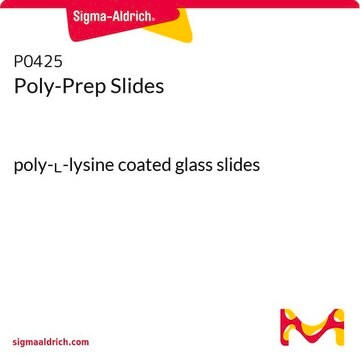LPLL001
Laminin/Poly-L-Lysine Coating Solution
0.2 μm filtered, BioReagent, suitable for cell culture, Ready-to-use mixture
Iniciar sesiónpara Ver la Fijación de precios por contrato y de la organización
About This Item
UNSPSC Code:
12352202
NACRES:
NA.75
Productos recomendados
Quality Level
sterility
0.2 μm filtered
product line
BioReagent
form
liquid
concentration
1 ×
technique(s)
cell culture | mammalian: suitable
shipped in
wet ice
storage temp.
2-8°C
General description
Laminin/Poly-L-Lysine Coating Solution is a ready-to-use attachment factors mix solution, prepared in phosphate-buffered saline and is 0.2µm filtered. It is used to coat cell culture flasks, dishes, and multi-well plates and used to promote the attachment, spreading and proliferation of variety of cell types that require ECM-coated surface for adhesion and 2D cell-culture growth. The combination of Poly-L-Lysine and Laminin has been used for optimal attachment and promotion of neurite outgrowth in culture. It is suitable for culturing many different types of Peripheral Nervous System (PNS) and Central Nervous System (CNS) networks and is useful for promoting neural cell attachment and differentiation. Certain cells can digest Poly-L-lysine, in which case the Laminin/Poly-D-Lysine solution can be used (Cat# LPDL001).
application
Laminin/Poly-L-Lysine Coating Solution can be used in:
- Attachment and spreading of a variety of cell types
- Enhancement of neuronal cell attachment to plastic and glass
- Support of neurite outgrowth
- Suitable for use with serum-free or reduced -serum cultures
Biochem/physiol Actions
Laminin proteins are integral components of structural scaffolding in animal tissues. Laminin has active domains for collagen binding, cell adhesion, heparin binding, and neurite outgrowth fragment. Laminin supports growth and differentiation of many cell types including epithelial, endothelial, neural, muscle and liver cells.
Poly-L-lysine hydrobromide is a nonspecific attachment factor for cells, useful in promoting cell adhesion to solid substrates by enhancing electrostatic interaction between negatively charged ions of the cell membrane and the culture surface. After absorption to the culture surface, Poly-L-lysine increases the number of positively charged cell binding sites.
Poly-L-lysine hydrobromide is a nonspecific attachment factor for cells, useful in promoting cell adhesion to solid substrates by enhancing electrostatic interaction between negatively charged ions of the cell membrane and the culture surface. After absorption to the culture surface, Poly-L-lysine increases the number of positively charged cell binding sites.
Components
Laminin is a large basement membrane glycoprotein and composed of three different polypeptide chains, termed α, β and γ. The cohesion between these chains is the result of many inter and intrachain disulfide bonds. Together, they cause the molecule to look like a crucifix.
Preparation Note
LPLL001 is a ready to use mixture composed of Laminin and Poly-L-Lysine. It is filtered using 0.2µm filter. Gently mix the Laminin/Poly-L-Lysine Coating Solution a few times to form a homogenous solution before use. For use as a coating solution, cover the entire culture surface area, approximately 0.2-0.25 mL/cm2. Incubate at room temperature for 2-3 hours and carefully aspirate the solution and wash 3 times with sterile PBS before plating cells. The coated tissue culture vessels can be used immediately or stored at 4 °C for up to one week filled with PBS and wrapped in parafilm. Remove PBS only when ready to plate the cells. Do not let the coated plates dry completely
Storage Class
12 - Non Combustible Liquids
wgk_germany
WGK 1
Certificados de análisis (COA)
Busque Certificados de análisis (COA) introduciendo el número de lote del producto. Los números de lote se encuentran en la etiqueta del producto después de las palabras «Lot» o «Batch»
¿Ya tiene este producto?
Encuentre la documentación para los productos que ha comprado recientemente en la Biblioteca de documentos.
Nuestro equipo de científicos tiene experiencia en todas las áreas de investigación: Ciencias de la vida, Ciencia de los materiales, Síntesis química, Cromatografía, Analítica y muchas otras.
Póngase en contacto con el Servicio técnico








